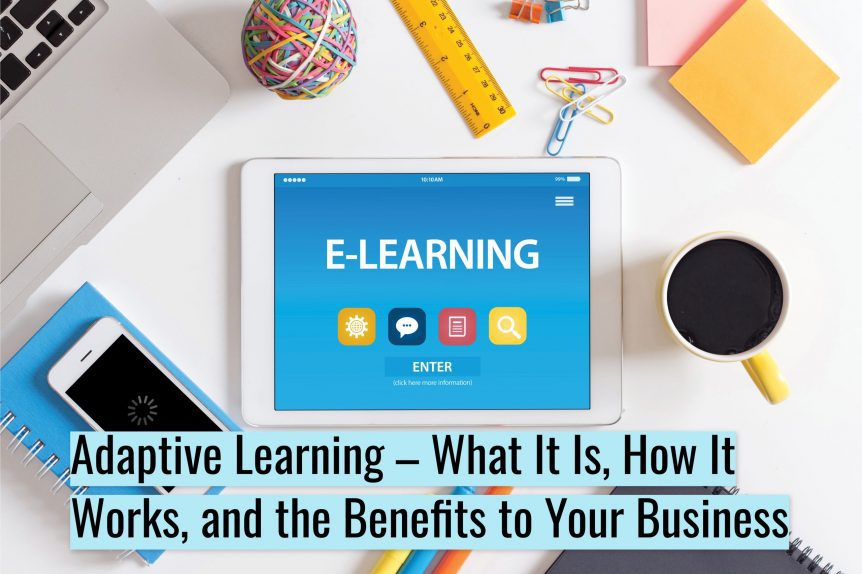Adaptive Learning – What It Is, How It Works, and the Benefits to Your Business
With the concept of adaptive learning, the days of everyone in your organisation receiving the same – or even very similar – training are fast becoming a thing of the past. The availability of new technologies, the demands of learners, and the return on investment that adaptive learning delivers, are combining to make this approach to creating e-learning content more and more common.
What is adaptive learning, though?
It is a bit of jargon used in the e-learning industry that can have a real and positive impact on the performance of your training strategy. At its core, adaptive learning is all about creating a personalised learning experience for each person completing a course or module.
A standard e-learning course is linear. In other words, each learner progresses through the course along the same path.
With adaptive learning, the path the learner takes varies according to the learner. So, for example, some learners might cover subject areas that others don’t, and some learners might get detail on a topic that others don’t require.
Personalisation Is the Future
This drive for delivering personalised learning experiences is part of a wider trend that is impacting multiple areas of life. In fact, personalisation is one of the big buzzwords in the world today.
Whether it is personalised products from manufacturers, prescribing personalised medicines, or enjoying personalised entertainment, there is an expectation now on companies to deliver services and products on a personal level.
The manufacturing sector is a good example of just how deep this is going. Traditionally, an optimised production line produces the same thing in as high a quantity as possible as fast as possible.
Today, however, manufacturers are moving towards having the capability to produce a unique product for each consumer with the same level of efficiency as manufacturing a single item at scale.
In other words, producing one unique, personalised product at a similar cost to producing a generic product that is manufactured in a production run of thousands, tens of thousands, or more.
This is important to understand as there are similar expectations when it comes to corporate training. Employees increasingly want training courses and content relevant to them personally, not training courses and content that are relevant to all those with their job title, or people in their department. Employees want deeper customisation levels than this.
The Role of E-Learning In Delivering Fully Customised Training Experiences
Delivering on this expectation for deep customisation in the learning experience would be extremely difficult to achieve with classroom-based learning. Even if it was logistically possible, is highly likely to be cost-prohibitive.
E-learning, however, makes such personalisation possible. The technologies involved, the skills of instructional designers, and the versatility of e-learning mean you can create e-learning courses that use an adaptive learning approach.
How it Works
The key to making adaptive learning work is feedback. In other words, the e-learning course adapts to the learner based on the feedback it receives.
For example, the feedback could be that the learner has sufficient knowledge in a particular subject area. The path that learner then takes through the course will skip past the sections that cover the subject they already know.
In e-learning, there are two main ways of doing this, i.e. two main ways of receiving feedback from learners and then using that information to create a personalised learning path. Let’s look at both.
Adaptive Learning by Design
This method involves designing the e-learning course with an if-this-then-that approach. In other words, it’s a rules-based approach.
As a result, the feedback is very straightforward as it involves asking questions of the learner directly.
For example, the course could ask the learner which job role they match and/or how they rate their knowledge of a particular topic. The path the learner takes is then determined by their answers to these questions.
Adaptive Learning by Algorithm
This is also known as algorithmic adaptivity. It involves using an algorithm to create personalised experiences. So, an algorithm could detect that a learner is getting all the questions in a quiz correct and is answering them very quickly. In this situation, it could suggest a new learning path that skips content the learner appears to already know or it could start giving the learner more difficult questions.
Another example is where an algorithm detects a user that is getting a lot of questions in a quiz wrong and/or is taking a long time to complete the quiz. In this situation, the algorithm could suggest the learner repeats content already completed. It could also offer the learner offshoot content that is not part of the main course but will help with the topic the learner is struggling with.
The Benefits of Adaptive Learning
Whatever approach you take to implementing adaptive learning in your training strategy, it will require an investment in time and money. Here are the benefits that adaptive e-learning courses offer in return for that investment:
- Improves results – learners will grasp the subject matter faster and they will retain the information as it will make more sense to them.
- Increases satisfaction – adaptive learning prevents learners from becoming frustrated with a course they think is progressing too slowly while also helping build the confidence of learners who need more time, help, and support.
- Makes learning faster – as learners don’t have to complete sections on subjects they are already familiar with, they will get through the course faster.
- Creates behavioural change – most training in corporate environments is about creating behavioural change. Making the learning experience more personal helps to achieve this.
- Delivers better return on investment – taking all the above together, adaptive learning delivers an enhanced return on investment compared to creating linear content.
Adaptive learning won’t be the solution for all your e-learning courses, but you should consider using this approach where it will be beneficial.
